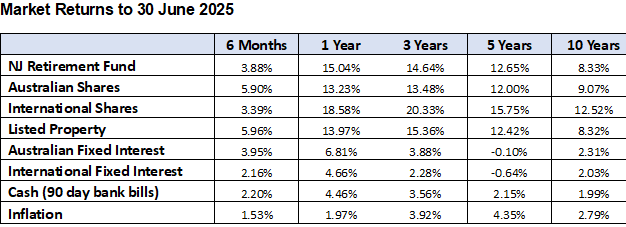Market Movements
The market has recovered all of the losses incurred from Trump’s tariff announcement in April. The reason given for this is that traders believe that Trump always chickens out – he reverses his position when the level of negative feedback becomes too great. He has deferred implementation of some tariffs until 1 August so we will soon know if they are right it not.
This is a very optimistic view as it likely that at some point he will make a mistake that will be too hard to fix. An attempt to fire Federal Reserve Chairman Jerome Powell could be in that category.
All Ords Index


New $3m Super Tax (Div 296)
This proposal was dead and buried before the May election. After the ALP won convincingly, crushing both the LNP and Greens there was a media frenzy suggesting that the $3m tax was guaranteed to pass now.
The new government returned to Parliament this week and announced their top prioriites:
- Wiping student debt (cutting it by 20%).
- Increasing safety measures for children in childcare.
- Protecting weekend penalty rates.
- Building 1.2m new homes.
There is no mention of the new Super Tax so maybe the media got this completely wrong?
US Economy
The US unemployment rate is currently 4.2%. The latest CPI for the month of June is 2.7%. Both of these figures are relatively low. The CPI is low is despite tariffs of at least 10% being placed on most imports. Tariff revenue has now exceeded US$100 billion. The theory is that businesses are largely absorbing the cost of tariffs into their profit margins instead of increasing prices.
The downside is that instead of inflation going up company profits will go down which is not great for the sharemarket either. If companies cannot pass on the cost of tariffs they may go bankrupt which is very bad news for the economy.
The US Federal Reserve has been holding the official cash interest rate at 4.33% with a range of 4.25% to 4.50%. They are waiting to see the impact of
New Trade Reality
The North American Free Trade Agreement commenced on 1 January 1994. This agreement was beneficial to the overall economy of the US but it was the start of a process of US companies relocating their factories to countries with lower wages than the US. When China joined the World Trade Organisation on 11 December 2001 this trend accelerated.
By 2016 Tariffs in most developed countries were relatively low and averaged 2-3%. Consumers benefited by having access to cheap imports but factory workers lost their jobs and their communities stagnated.
Donald Trump has now negotiated some kind of trade deal with the European Union and Japan with a 15% baseline tariff. The average tariff will now be around 20%. This is a significant change to global trading arrangements so we will have to wait to see what impact it has on markets and economies.
